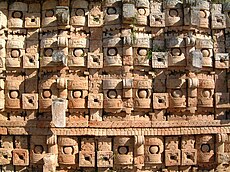Кабах: различия между версиями
| [отпатрулированная версия] | [отпатрулированная версия] |
← Новая страница: «{{Subst:L}} thumb|right|230px|Portion of «Temple of the Masks» facade as drawn by [[Frederick Catherwood.]][[Im...» |
м робот добавил: en:Kabah (Maya site) |
||
| Строка 30: | Строка 30: | ||
[[de:Kabah]] |
[[de:Kabah]] |
||
[[ |
[[en:Kabah (Maya site)]] |
||
[[eo:Kabah]] |
[[eo:Kabah]] |
||
[[es:Kabáh]] |
|||
[[it:Kabah]] |
[[it:Kabah]] |
||
[[nl:Kabah]] |
[[nl:Kabah]] |
||
Версия от 16:01, 1 января 2009
Эту страницу в данный момент активно редактирует участник Dmitri Lytov. |
[[Категория:Википедия:Ошибка выражения: неожидаемый оператор <, редактируемые прямо сейчас]]


Kabah (also spelled Kabaah, Kabáh, Kahbah and Kaba) is a Maya archaeological site in the south-east of the Mexican state of Yucatán.
Kabah is to the south of Uxmal, and is connected to that city by a grand 18 km long raised pedestrian causeway 5 meters wide with monumental arches at each end. Kabah is the second largest ruin of the Puuc region after Uxmal.
The name «Kabah» or «Kabaah» is usually taken to be archaic Maya language for «strong hand». This is a pre-Columbian name for the site, mentioned in Maya chronicles. An alternative name is Kabahaucan or «royal snake in the hand».
The area was inhabited by the mid 3rd century BC. Most of the architecture now visible was built between the 7th century and the 11th century. A sculpted date on a doorjamb of one of the buildings gives the date 879, probably around the city’s height. Another inscribed date is one of the latest carved in the Maya Classic style, in 987. Kabaah was abandoned or at least no new ceremonial architecture built for several centuries before the Spanish conquest of Yucatán.
The most famous structure at Kabah is the «Palace of the Masks», the façade decorated with hundreds of stone masks of the long-nosed rain god Chaac; it is also known as the Codz Poop, meaning «Rolled Matting», from the pattern of the stone mosaics. This massive repetition of a single set of elements is unusual in Maya art, and here is used to unique effect.

Masks of the rain god abound on other structures throughout the site. Copal incense has been discovered in some of the stone noses of the raingods.
The site also has a number of other palaces, low stone buildings, and step-pyramid temples. While most is in the Puuc Maya style, some show Chenes elements. The site had a number of sculpted panels, lintels, and doorjambs, most of which have been removed to museums elsewhere. The sculptures mostly depict the site’s rulers and scenes of warfare.
The first detailed account of the ruin was published by John Lloyd Stephens and Frederick Catherwood in 1843.
The site is on Mexican highway 261, some 140 km south from Mérida, Yucatán, towards Campeche, Campeche, and is a popular tourism destination. Ruins extend for a considerable distance on both sides of the highway; many of the more distant structures are little visited, and some are still overgrown with forest. на 2003 год, a program is ongoing to clear and restore more buildings, as well as archeological excavations under the direction of archeologist Ramón Carrasco.
Kabah was declared a Yucatán state park in 1993.
External links
- Kabah on MayaInfo.org with photos
- Kabáh on sci.mus.mn.us more photos
Kabah web site at Reed College. Over 300 19th — 21st century photographs of Kabah. http://academic.reed.edu/uxmal/